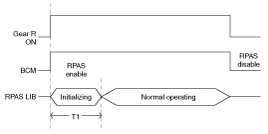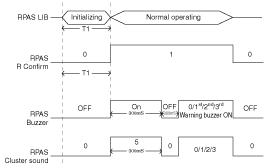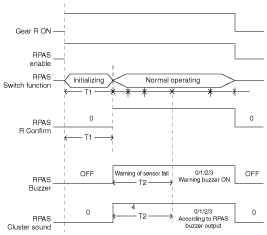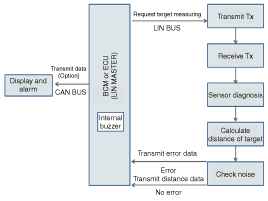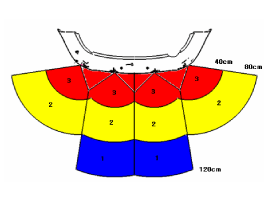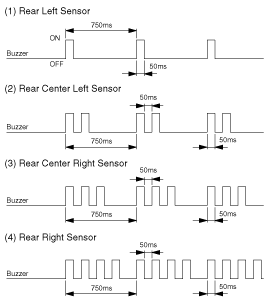 Kia Sportage: Rear Parking Assist System Control Unit: Description and Operation
Kia Sportage: Rear Parking Assist System Control Unit: Description and Operation
Third generation SL (2010ŌĆō2016) / Kia Sportage SL Service & Repair Manual / Body Electrical System / Rear Parking Assist System / Rear Parking Assist System Control Unit: Description and Operation
| Description |
When reversing, the driver is not easy to find objects in the
blind spots and to determine the distance from the object. In order to
provide the driver safety and convenience, back warning system will
operate upon shifting to "R" Ultrasonic sensor will emit ultrasonic wave
rearward and detect the reflected wave.
Control unit (BCM) will calculate distance to the object
using the sensor signal input and output buzzer alarm in three steps
(first, second and third alarm).
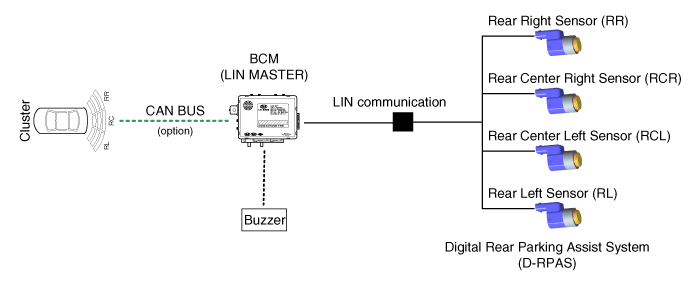
| Block Diagram |
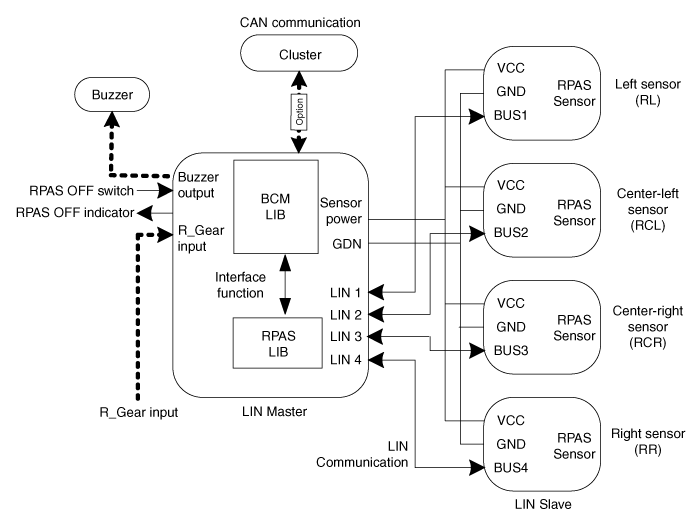
| Operation |
System Operation
| Initial Mode |
| 1. |
RPAS checks the ID and Reference (shaping table) during the initialization using LIN communication. |
| 2. |
If sensor ID or sensor parameter is same with expected value,
RPAS system is initialized within 500ms after turning IGN1 and shifting
R gear. |
| 3. |
If Sensor ID or sensor parameter is different with expected
value, initial mode can take about 1.2 second after turning IGN1 and
shifting R gear because of teaching sensor ID or sensor parameter. |
| 4. |
RPAS executes the diagnosis of each sensor during the initialization.
T1 : RPAS initializing time
|
| Normal Mode |
Normal mode of RPAS can divide as two steps.
First step is a mode to inform the driver of the RPAS system
ON and diagnosis results which is executed during the initialization.
Second step is the obstacle detection mode to give driver warning when detecting the obstacle.
| 1. |
Driver info mode for RPAS ON
|
| 2. |
Obstacle detection mode
|
| Detection Area |
| 1. |
Test condition ŌĆō PVC pole(Diameter 75mm, Length 1m) & At the room temperature |
| 2. |
Distance tolerance (measured at the front of sensor)
81 cm ~ 120 cm : ┬▒ 15 cm
41 cm ~ 80 cm : ┬▒ 10 cm
Below 40 cm : ┬▒ 10 cm |
| 3. |
Below 30 cm may not be detected. |
| 4. |
Sensing zone specification
Sound pulse has a fixed duration.
Pause between pulses is related to the distance from the obstacle and is not variable.
Although the position of the obstacle is not moving during
sometime, the buzzer should keep warning. And although an obstacle that
is currently warned is getting far, the buzzer should keep warning
according to obstacle distance.
The warning sound is generated by the algorithm of ECU which measures the distance of the obstacle from the sensor.
The distance is divided into three detection ranges. Obstacles below 30cm from the sensor may not be detected.
|
Each Warning Zone Hysteresis Function for buzzer and display.
| Condition | 1st Warning (120cm) | 2nd Warning (80cm) | 3rd Warning (40cm) |
| the distance between vehicle and obstacle is getting close | Immediately warning | ||
| the distance between vehicle and obstacle is getting far | 2sec warning delay | 2sec warning delay | 1sec warning delay |
| Warning method of RPAS |
If RPAS sensor detects the obstacle, the acoustic device
makes warning sound and the display module (Cluster) indicates each
warning level as like followings.
RPAS sensor sends the distance data to BCM through LIN communication and BCM received the distance data from each sensor.
BCM has the responsibility of the acoustic function.
BCM has the responsibility of the gateway function that BCM sends the warning data to Cluster as like below timing diagram.
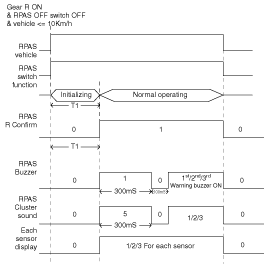
When change from a warning area to the different zone, after
finishing one cycle of warning output, the next warning sound has to
start for different zone necessarily.
| Timing Chart for RPAS Warning Sound |
If Power is supplied to the system (turning IGN1 and shifting
R gear), BCM checks the channel of each sensor and if no problems, the
buzzer sound with turn-on period 300ms is generated after 500ms, but
even if one sensor has a problem, the buzzer sound not for
ŌĆ£Start-buzzer of RPASŌĆØ but for ŌĆ£Diagnosis-buzzer of RPASŌĆØ, The
next action for Normal mode is like followings.
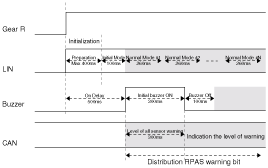
After R gear is armed, the system operation is like followings.
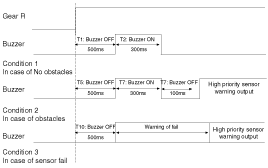
Time tolerance: ┬▒10%
After R gear is disarmed, the system operation is like followings.
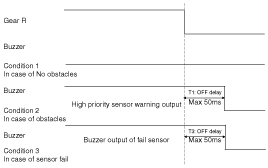
Time tolerance: ┬▒10%
| Sensor interval distance dividing alarm output specification |
The condition logic is as below according to phase logic in priority. (In same sensor)
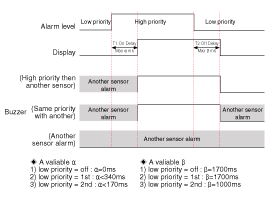
RPAS operation ranges according to distance are as below.
| 1. |
First alarm (81 cm ~ 120 cm)
|
| 2. |
Secondary alarm (41 cm ~ 80 cm)
|
| 3. |
Third alarm (40 cm or less)
|
| 4. |
Failure alarm cycle
When the system starts and sensor has errors, the warning sound as the sensor position is like following.
? In the case that the multiple sensors have errors, the sequence of sensorŌĆÖs warning is like followings.
RL > RCL > RCR > RR
? After the warning sound for diagnosis is generated, the
other normal sensors execute the normal function such as the detection
and the transmission of distance data.
|
| Method of error handling |
?nbsp; LIN BUS Off error
| Division | Condition for error | Condition for the disarmed |
| Initial routine | Detecting LIN BUS OFF one time | Disarmed (if LIN BUS ON is detected 4 consecutive times in general routine) |
| Normal routine | Detecting LIN BUS OFF 4 consecutive times | Disarmed (if LIN BUS ON is detected 4 consecutive times) |
? Remarks
| 1. |
LIN BUS OFF means no response from sensors when BCM send request to sensors. |
| 2. |
In the case that error happens to the initial routine, diagnosis warning sound + display for error |
| 3. |
In the case that error happens to the Normal routine, the only display for error |
| 4. |
If error happens to the direct condition of each sensor,
after that, error is transmitted at the indirect condition (sensor
side). |
?nbsp; In the case of sensor error
| Division | Condition for error | Condition for the disarmed |
| Initial routine | Detecting the message of sensor error | Disarmed(if
the message which sensor is normal is detected 4 consecutive times ,
but it is impossible to be disarmed in the initial routine) |
| General routine | Detecting the message of sensor error 4 consecutive times | Disarmed(if the message which sensor is normal is detected 4 consecutive times) |
? Remarks
| 1. |
In the case of fault counting output message or signal with last valid should be transmitted. |
| 2. |
In the case that error happens to the initial routine, diagnosis warning sound + display for error |
| 3. |
In the case that error happens to the general routine, the only display for error |
 Rear Parking Assist System Control Unit: Components and Components Location
Rear Parking Assist System Control Unit: Components and Components Location
Component Location
...
 Ultrasonic Sensor: Components and Components Location
Ultrasonic Sensor: Components and Components Location
Components Location
...
Other Information:
Filler-Neck Assembly: Repair procedures
Removal
1.
Remove the rear-LH wheel, tire, and the inner wheel house.
2.
Disconnect the fuel filler hose (A) and the ventilation hose (B).
3.
Open the fuel filler door and unfasten the fil ...
Battery replacement
A transmitter uses a 3 volt lithium battery which will normally last for several
years. When replacement is necessary, use the following procedure.
1.Insert a slim tool into the slot and gently p ...
Categories
- Home
- Kia Sportage QL (2015-2019) Owners Manual
- Kia Sportage QL (2015-2019) Service Manual
- Kia Sportage SL 2010-2016 Owners Manual
- Kia Sportage SL 2010-2016 Service Manual
Copyright ® www.kispmanual.com 2014-2025

